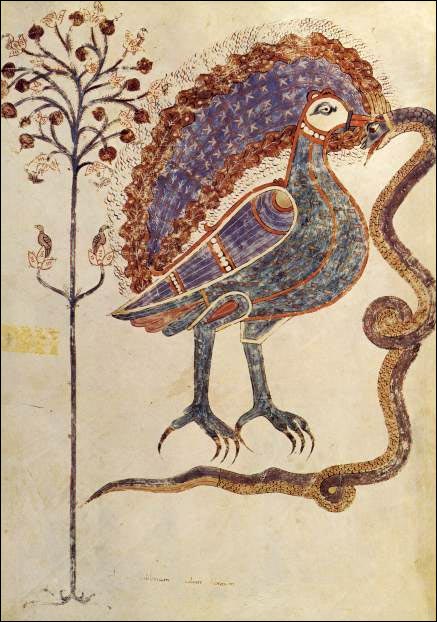 |
Combat of the Bird and Serpent--5Ck.152 Date 975. Origin The Western World : Medieval Period : 9th - 10th Centuries : Enamel Description A brilliantly colored, sharply taloned, and bejeweled bird, its tail feathers flung forward over its head, holds a serpent in its beak in a death blow. To the left of the scene stands a highly stylized tree of life, with two small birds perched symmetrically on lower limbs. Cultural Context This illuminated parchment illustrating a commentary by the Asturian monk, Beatus of Liebana (mid 8th century A.D.) was completed in the monastery of San Salvador de Tabara by the monk Emeterius and an assistant, Ende, in 975. It is now located in the Cathedral of Gerona, Spain. Beatus was the most important Spanish Bible commentator of that time, and his Commentary on the Apocalypse (the Book of Revelation) was the most important text in Spanish illuminations. An allegorical text written near this picture gives the contemporary understanding of this scene: "There is said to be in the East a bird with a large and very hard beak who with a challenging hiss dares the serpent to do battle. He then deceptively covers with dirt the colorful gems with which nature has so lavishly adorned him. His surprising and humble appearance leads the serpent to be careless and overconfident. Then the bird, with his tail held before his face as a shield, attacks the head of the startled beast and pierces his brain with sharp blows. So Christ in his incarnation clothed himself in the impurity of our flesh that through a pious trick he might fool the evil deceiver. He concealed his Godhead behind the tail of his manhood, so to speak, and with the word of his mouth slew the venomous killer, the devil. As the Apostle says, 'Through the word of his mouth he will kill the wicked.'" In the Book of Revelation we find several references which can stand as background for the conceptions of Christ and his victory over evil pictured here. Throughout the Book Satan, the Devil, and evil forces in general are pictured as serpents, multi-headed dragons, and related images, while Christ, his mother and the angels helping him are depicted as birds, eagles, or as winged angels flying in the heavens. In Revelation 12, after the woman "clothed with the sun, with the moon under her feet, and on her head a crown of twelve stars" (vs. 1) had born the son "who is to rule the nations with a rod of iron," (vs. 5) then "that ancient serpent, who is called the Devil and Satan," (vs. 9) who had opposed the woman and had sought to devour her child, was cast down to the earth. As he sought to pursue the woman she "was given the wings of the great eagle that she might fly from the serpent...." (vss. 13-14). In Revelation 19 an angel summons the birds of prey to gather "for the great supper of God, to eat the flesh of mighty men, the flesh of horses and their riders. . . ." (vss. 17-18--i.e. to the final battle between Christ and the anti-Christ). Of course, the primary Biblical reference to Satan as a serpent, and thus to the serpent as the embodiment of evil is the account of the Garden of Eden in Genesis: "Now the serpent was more subtle than any other wild creature that the Lord God had made." (3:1). The serpent then proceeded to tempt the woman to eat of the fruit of the tree of the knowledge of good and evil (the tree pictured in this illumination), the eating of which would cause death to come upon humankind. (2:16-17; 3:1-7). Herein we see the ambivalent character of the serpent, one who brings wisdom from the earth, who causes humankinds' "eyes to be opened," to "be like God, knowing good and evil." (Genesis 3:5). Nevertheless, the serpent was cursed for his acts, and "enmity" was established "between your seed [i.e., the serpent's=Satan] and her seed [i.e., Eve's seed=Christ]. "He shall bruise your head, and you shall bruise his heel." (Genesis 3:15). As in the allegory quoted above, Satan will think that he can thwart the intentions of God ("you shall bruise his heel"--the serpent crawls along the ground), but Christ will destroy Satan ("He shall bruise your head"--as we see the bird here crushing the head of the serpent--compare Romans 16:20: "then the God of peace will soon crush Satan under your feet.") The tree of life in the scene possesses the ambivalent imagery of the "Tree of the Knowledge of Good and Evil" in the Garden of Eden, the eating of the fruit of which by Eve brought death on her posterity, but also at the same time brought to humankind the condition of being "like God, knowing good and evil." (Genesis 3:5). In other words, the Tree of Life, which rises up out of the waters of creation, brings with it both life and death, both of which together equal the wholeness of exist- ence and the mysteries which death, the underworld, hides. The serpent is the guardian of this underworld, as the Python at the oracle of Delphi. References Williams, John. Early Spanish Manuscript Illumination. New York: George Braziller, 1977. |